Antibody data
- Antibody Data
- Antigen structure
- References [1]
- Comments [0]
- Validations
- ELISA [1]
- Immunocytochemistry [2]
- Other assay [6]
Submit
Validation data
Reference
Comment
Report error
- Product number
- MA5-20125 - Provider product page

- Provider
- Invitrogen Antibodies
- Product name
- KLF10 Monoclonal Antibody (3E11)
- Antibody type
- Monoclonal
- Antigen
- Recombinant full-length protein
- Description
- Peptide Sequence: LSDTAKPHIA APFKEEEKSP VSAPKLPKAQ ATSVIRHTAD AQLCNHQTCP MKAASILNYQ NNSFRRRTHL NVEAARKNIP CAAVSPNRSK CERNTVADVD
- Reactivity
- Human
- Host
- Mouse
- Isotype
- IgG
- Antibody clone number
- 3E11
- Vial size
- 100 μg
- Concentration
- 0.5 mg/mL
- Storage
- -20°C, Avoid Freeze/Thaw Cycles
Submitted references A KDM6A-KLF10 reinforcing feedback mechanism aggravates diabetic podocyte dysfunction.
Lin CL, Hsu YC, Huang YT, Shih YH, Wang CJ, Chiang WC, Chang PJ
EMBO molecular medicine 2019 May;11(5)
EMBO molecular medicine 2019 May;11(5)
No comments: Submit comment
Supportive validation
- Submitted by
- Invitrogen Antibodies (provider)
- Main image
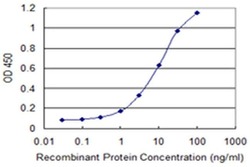
- Experimental details
- Detection limit for recombinant GST tagged KLF10 using anti-KLF10 monoclonal antibody (Product # MA5-20125) is 0.1 ng/mL as a capture antibody.
Supportive validation
- Submitted by
- Invitrogen Antibodies (provider)
- Main image
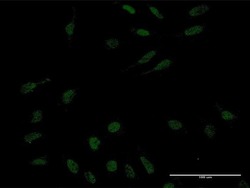
- Experimental details
- Immunofluorescence analysis of HeLa cells using an anti-KLF10 monoclonal antibody (Product # MA5-20125). (antibody concentration 10 µg/mL).
- Submitted by
- Invitrogen Antibodies (provider)
- Main image
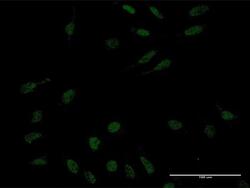
- Experimental details
- Immunofluorescence analysis of HeLa cells using an anti-KLF10 monoclonal antibody (Product # MA5-20125). (antibody concentration 10 µg/mL).
Supportive validation
- Submitted by
- Invitrogen Antibodies (provider)
- Main image
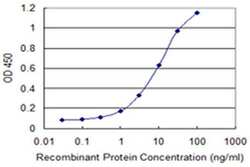
- Experimental details
- Detection limit for recombinant GST tagged KLF10 using anti-KLF10 monoclonal antibody (Product # MA5-20125) is 0.1 ng/mL as a capture antibody.
- Submitted by
- Invitrogen Antibodies (provider)
- Main image
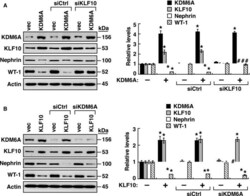
- Experimental details
- Figure EV4 KLF 10 is dominant over KDM 6A in mediating down-regulation of nephrin and WT -1 A Effects of KDM6A overexpression in combination with KLF10 knockdown on the expression of podocyte-specific markers. Relative levels of KDM6A, KLF10, nephrin, and WT-1 expressed in podocytes that were transfected with the indicated plasmids, and siRNAs were determined by Western blot analysis. * P < 0.05 versus vector-transfected podocytes, # P < 0.05 versus podocytes transfected with KDM6A and control siRNA (parametric ANOVA and a Bonferroni post hoc test; n = 3). B Effects of KLF10 overexpression in combination with KDM6A knockdown on the expression of podocyte-specific markers. Relative levels of KDM6A, KLF10, nephrin, and WT-1 expressed in podocytes that were transfected with the indicated plasmids and siRNAs were determined by Western blot analysis. * P < 0.05 versus vector-transfected podocytes, # P < 0.05 versus podocytes transfected with KLF10 and control siRNA (parametric ANOVA and a Bonferroni post hoc test; n = 3). Data information: Data are expressed as mean +- SEM. See the exact P -values for comparison tests in Appendix Table S10 . Source data are available online for this figure.
- Submitted by
- Invitrogen Antibodies (provider)
- Main image
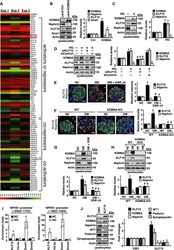
- Experimental details
- Figure 5 KLF 10 is a downstream effector of KDM 6A and is capable of directly binding to nephrin gene promoter A Screening of the potential KDM6A-regulated transcriptional factors involved in repression of nephrin expression. After transduction with a control lentiviral vector or a lentiviral vector expressing KDM6A into primary podocytes for 48 h, intracellular RNAs were isolated and used for RNA sequencing (RNA-Seq) analysis. The transcript expression patterns of 86 selected transcriptional factors from three independent RNA-Seq experiments are presented in a heat map. Notably, among these 86 selected genes, KLF10 is the most up-regulated gene. B Validation of increased KDM6A and KLF10 expression in primary podocytes that were infected with an empty lentiviral vector or KDM6A-expressing lentiviral vector for 48 h. * P < 0.05 versus the empty vector control (Wilcoxon two-sample test; n = 3). C Increased expression of KDM6A and KLF10 in primary podocytes cultured in high glucose for 48 h. * P < 0.05 versus normal controls (Wilcoxon two-sample test; n = 3). D Effect of KLF10 knockdown on high glucose-mediated reduction of nephrin in primary podocytes. As noted, knockdown of KLF10 prevented down-regulation of nephrin and up-regulation of KDM6A in high glucose-treated podocytes. * P < 0.05 versus normal controls, # P < 0.05 versus control siRNA with HG incubation (parametric ANOVA and a Bonferroni post hoc test; n = 3). E Immunofluorescence analysis of KLF10 and nephrin in renal
- Submitted by
- Invitrogen Antibodies (provider)
- Main image
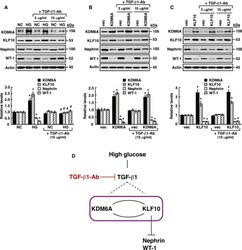
- Experimental details
- Figure EV5 Addition of a TGF -beta1-neutralizing antibody has no significant effects on the positive inter-regulation between KDM 6A and KLF 10 in podocytes A Effects of TGF-beta1 neutralization on high glucose-mediated gene expression. Podocytes cultured in normal or high glucose were treated with different doses (3 and 10 mug/mL) of TGF-beta1-neutralizing antibody (MAB240, R&D Systems) for 48 h. Relative protein levels of KDM6A, KLF10, nephrin, and WT-1 in these treated podocytes were analyzed by Western blot analysis. * P < 0.05 versus normal controls, # P < 0.05 versus podocytes in high glucose (parametric ANOVA and a Bonferroni post hoc test; n = 3). B Effects of TGF-beta1 neutralization on KDM6A-mediated gene expression. Podocytes transfected with an empty vector or KDM6A-expressing plasmid were treated with different doses (3 and 10 mug/mL) of TGF-beta1 neutralizing antibody (MAB240, R&D Systems) for 48 h. Relative expression levels of KDM6A, KLF10, nephrin, and WT-1 in these treated podocytes were analyzed by Western blot analysis. * P < 0.05 versus podocytes transfected with an empty vector (parametric ANOVA and a Bonferroni post hoc test; n = 3). C Effects of TGF-beta1 neutralization on KLF10-mediated gene expression. Podocytes transfected with an empty vector or KLF10-expressing plasmid were treated with different concentrations (3 and 10 mug/mL) of TGF-beta1 neutralizing antibody (MAB240, R&D Systems) for 48 h. Relative expression levels of KDM6A, KLF10, nephrin,
- Submitted by
- Invitrogen Antibodies (provider)
- Main image
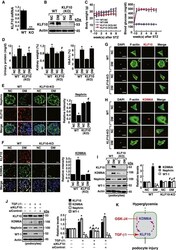
- Experimental details
- Figure 6 KDM 6A and KLF 10 can build a positive feedback loop that is critically involved in podocyte dysfunction A Quantitative RT-PCR evaluation of KLF10 mRNA expression in kidney samples of wild-type and KLF10 -knockout (KO) mice. ** P < 0.0001, significant difference versus wild-type controls (Wilcoxon two-sample test; n = 8). B Western blot analysis of KLF10 expression in kidney samples of wild-type or KLF10 -KO mice treated with or without STZ at 8 weeks after the onset of diabetes. Presented experiments were performed at least three times independently. C Changes in body weight and blood glucose levels in wild-type or KLF10 -KO mice with or without STZ treatment. No significant differences in body weights or blood glucose levels between diabetic wild-type mice and diabetic KLF10 -KO mice were detected (Wilcoxon two-sample test; n = 8). D Levels of urinary protein excretion, weights of kidney, and levels of HbA1c in wild-type or KLF10 -KO mice with or without STZ treatment. The mean relative kidney weight (%) shown in the study is determined as the percent of kidneys out of total body weight, and the HbA1c level is defined as the ratio of HbA1c to the total hemoglobin (% HbA1c; DCCT unit). * P < 0.05 versus untreated wild-type controls, # P < 0.05 versus STZ-treated wild-type mice (parametric ANOVA and a Bonferroni post hoc test; n = 8). E Immunofluorescence images of kidney sections stained with KLF10 and nephrin in wild-type or KLF10 -KO mice untreated or treated with
- Submitted by
- Invitrogen Antibodies (provider)
- Main image
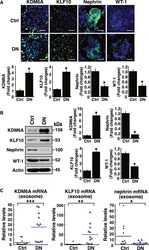
- Experimental details
- Figure 7 Elevated levels of KDM 6A and KLF 10 expression, along with decreased levels of nephrin (or WT -1) expression, are detected in kidney tissues and urinary exosomes of patients with diabetic nephropathy A Immunofluorescence analysis of kidney sections from diabetic nephropathy subjects and non-diabetic controls stained with KDM6A, KLF10, nephrin, and WT-1. Scale bars, 50 mum. * P < 0.05 by Wilcoxon two-sample test ( n = 6 for each group). B Western blot analysis of kidney tissues from non-diabetic controls and diabetic nephropathy subjects. Expression levels of KDM6A, KLF10, nephrin, and WT-1 in kidney tissues were determined by immunoblotting using the indicated antibodies. Relative protein levels in kidney tissues were normalized to actin. * P < 0.05 by Wilcoxon two-sample test ( n = 6 for each group). C Levels of KDM6A and KLF10, nephrin mRNAs in urine exosomes of diabetic nephropathy patients and non-diabetic controls. Relative mRNA levels in human urinary exosomes were normalized to 18S rRNA. Horizontal lines are medians. * P < 0.05, ** P < 0.01, and *** P < 0.001 by Wilcoxon two-sample test ( n = 12 for each group). Data information: Data are expressed as mean +- SEM (A and B). See the exact P -values for comparison tests in Appendix Table S7 .
 Explore
Explore Validate
Validate Learn
Learn Western blot
Western blot ELISA
ELISA